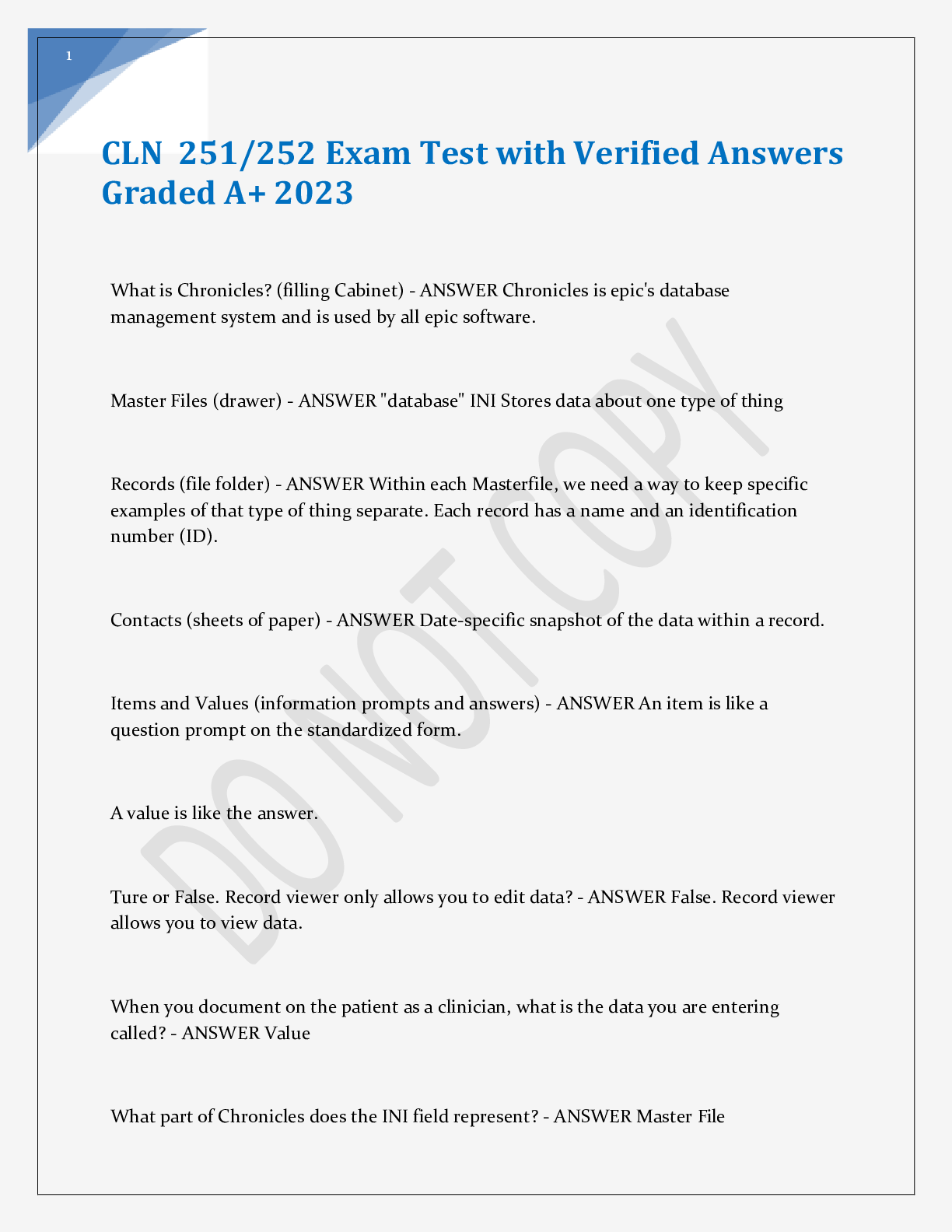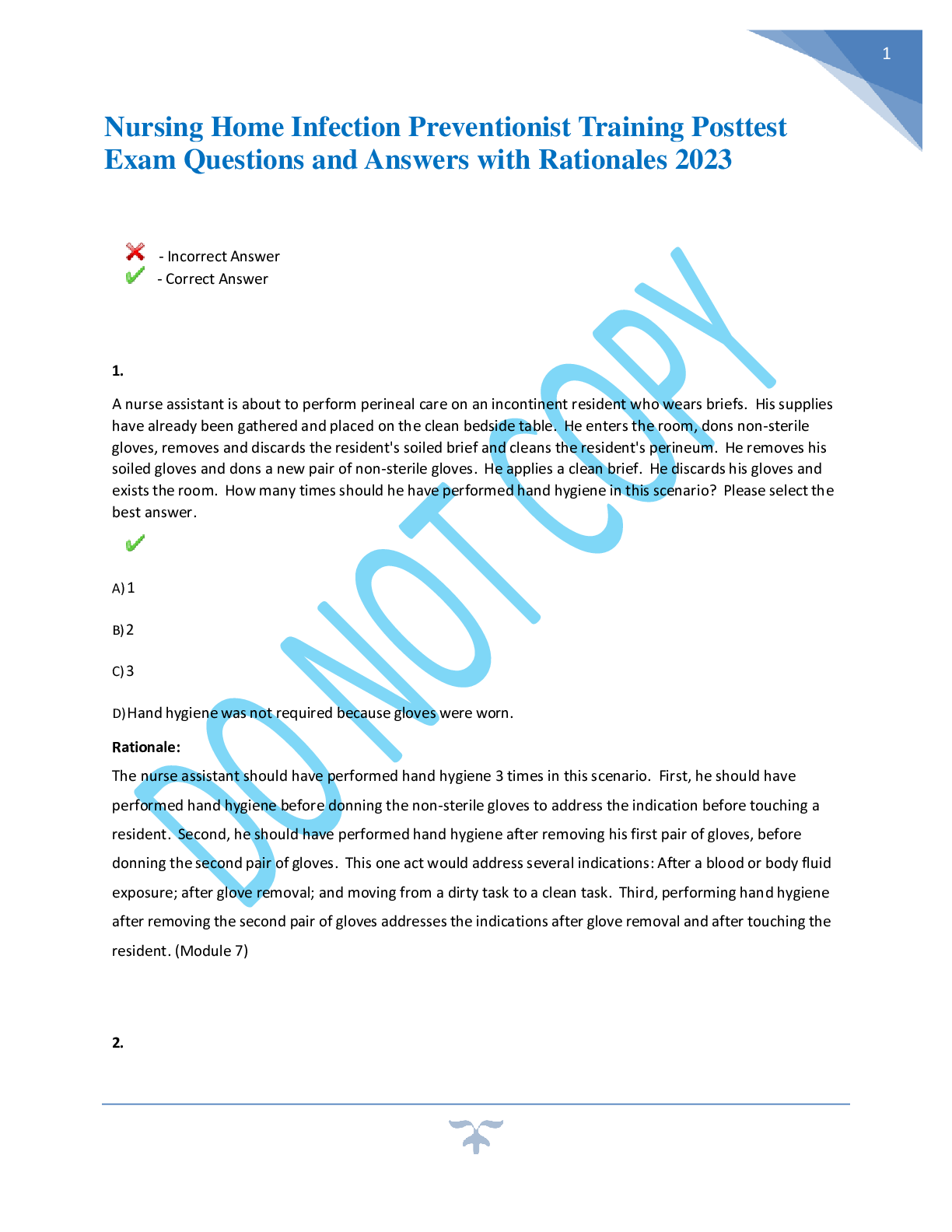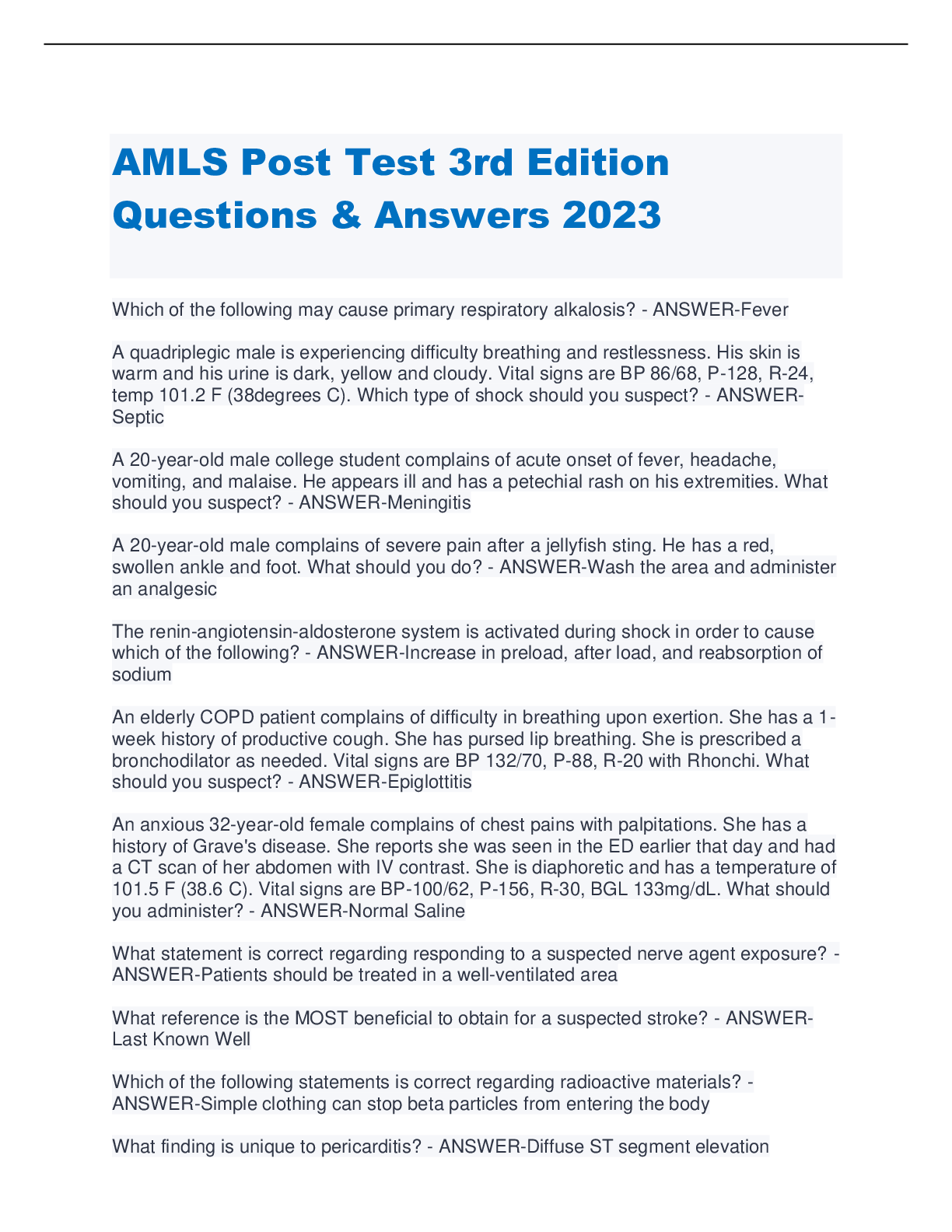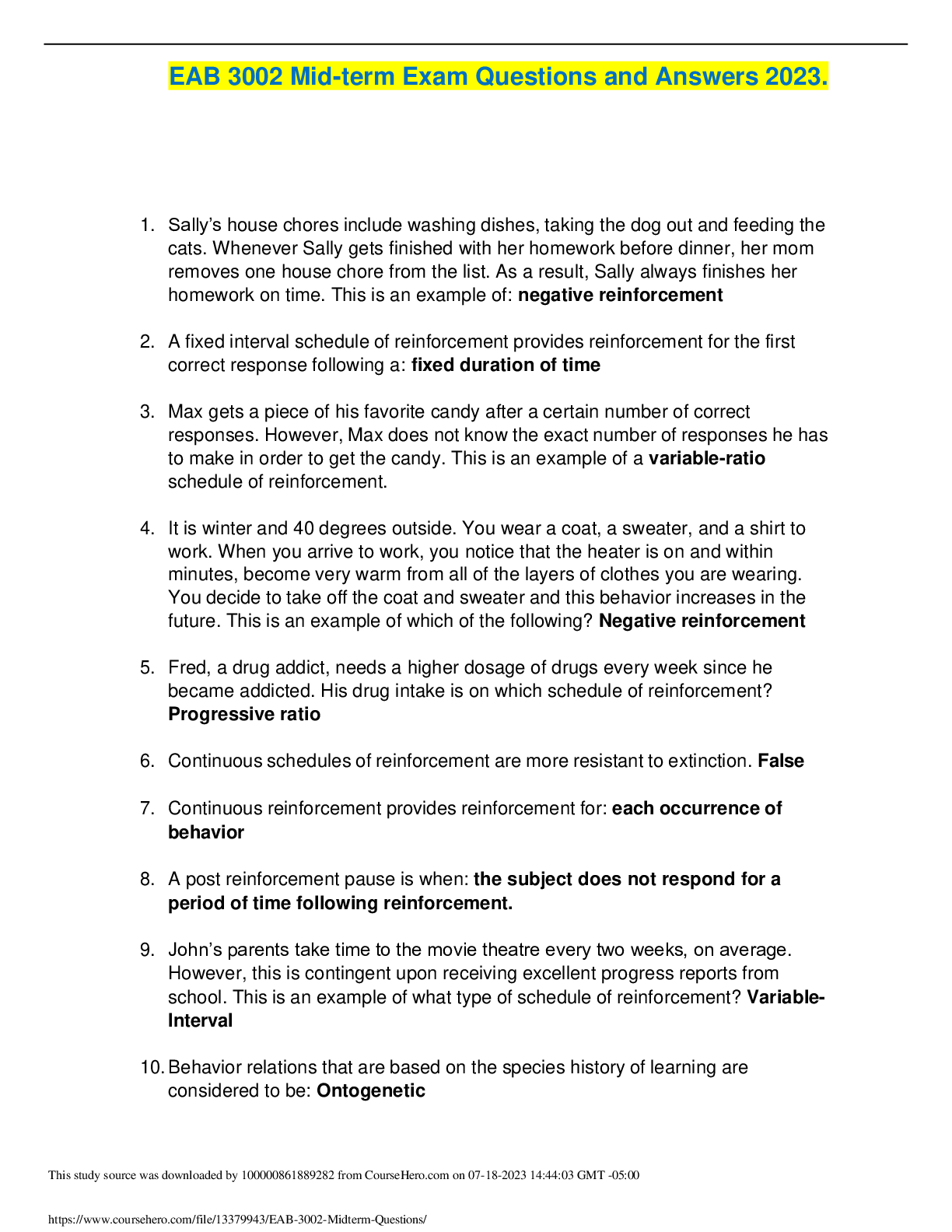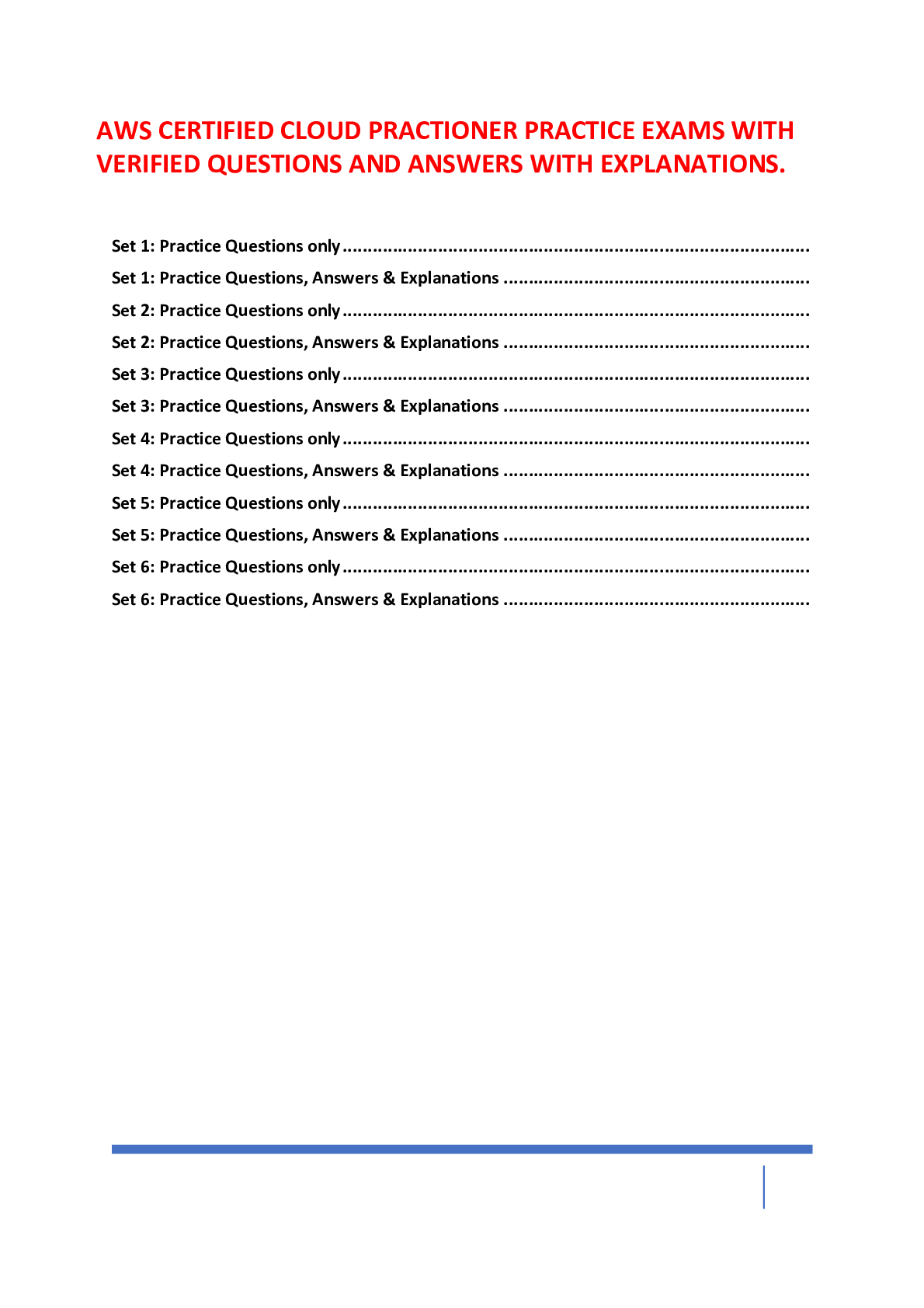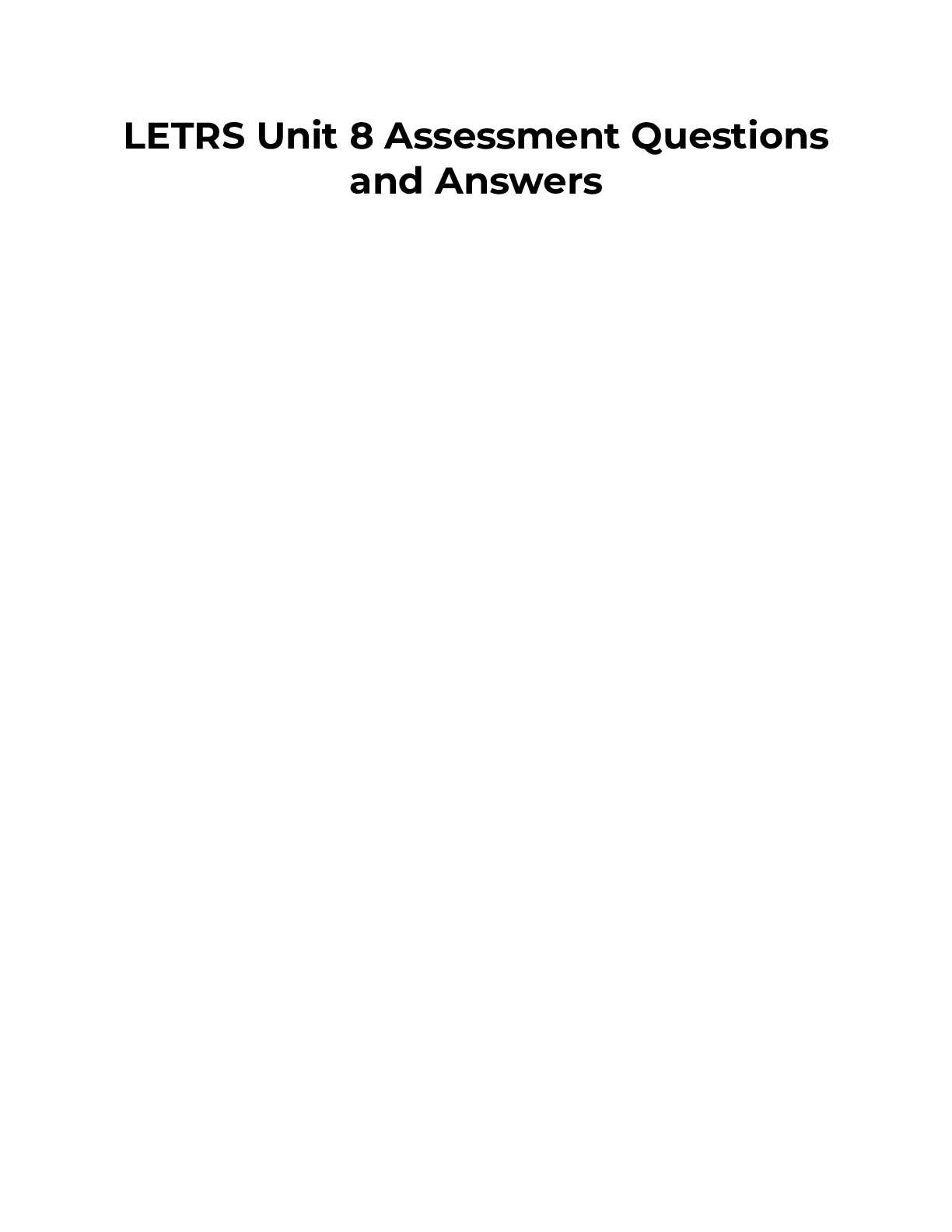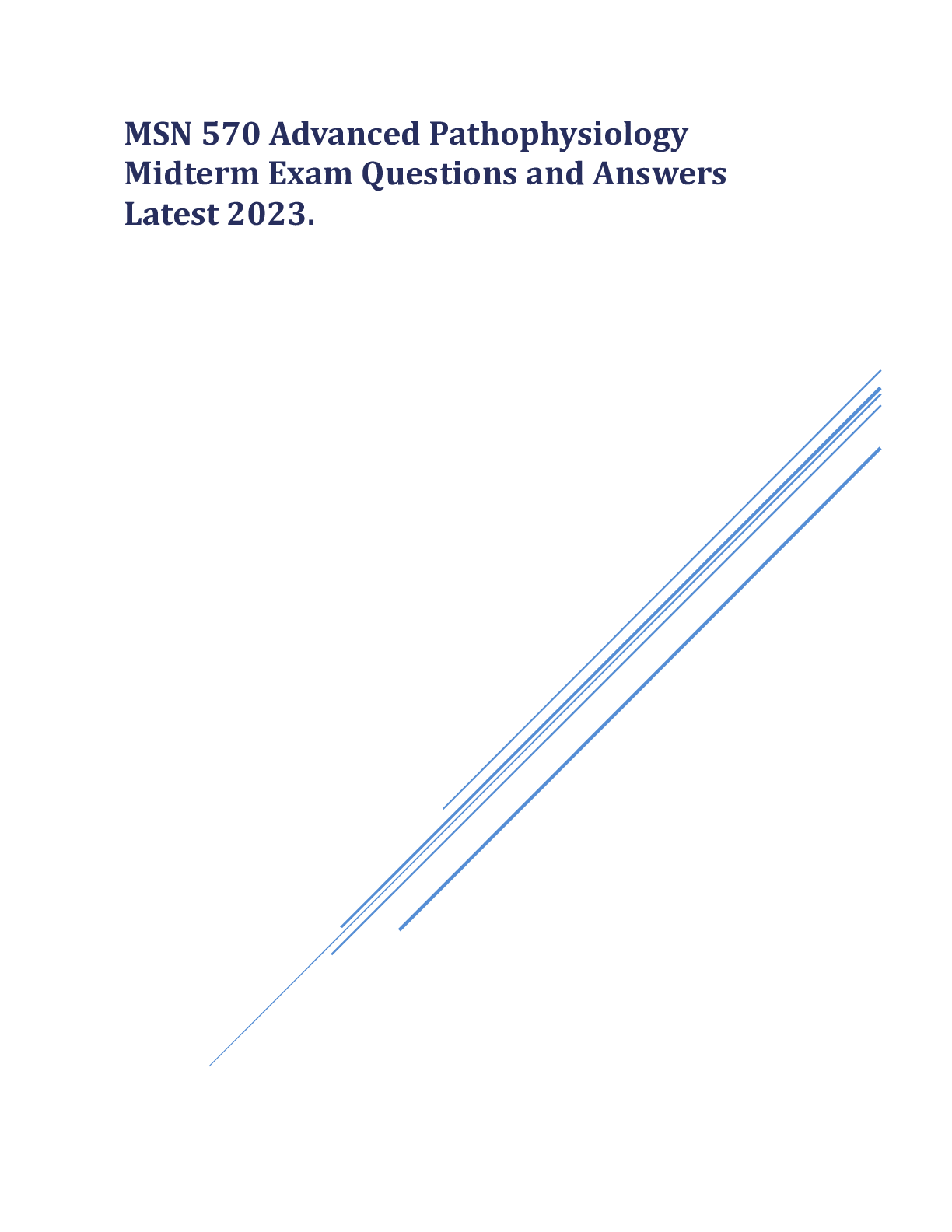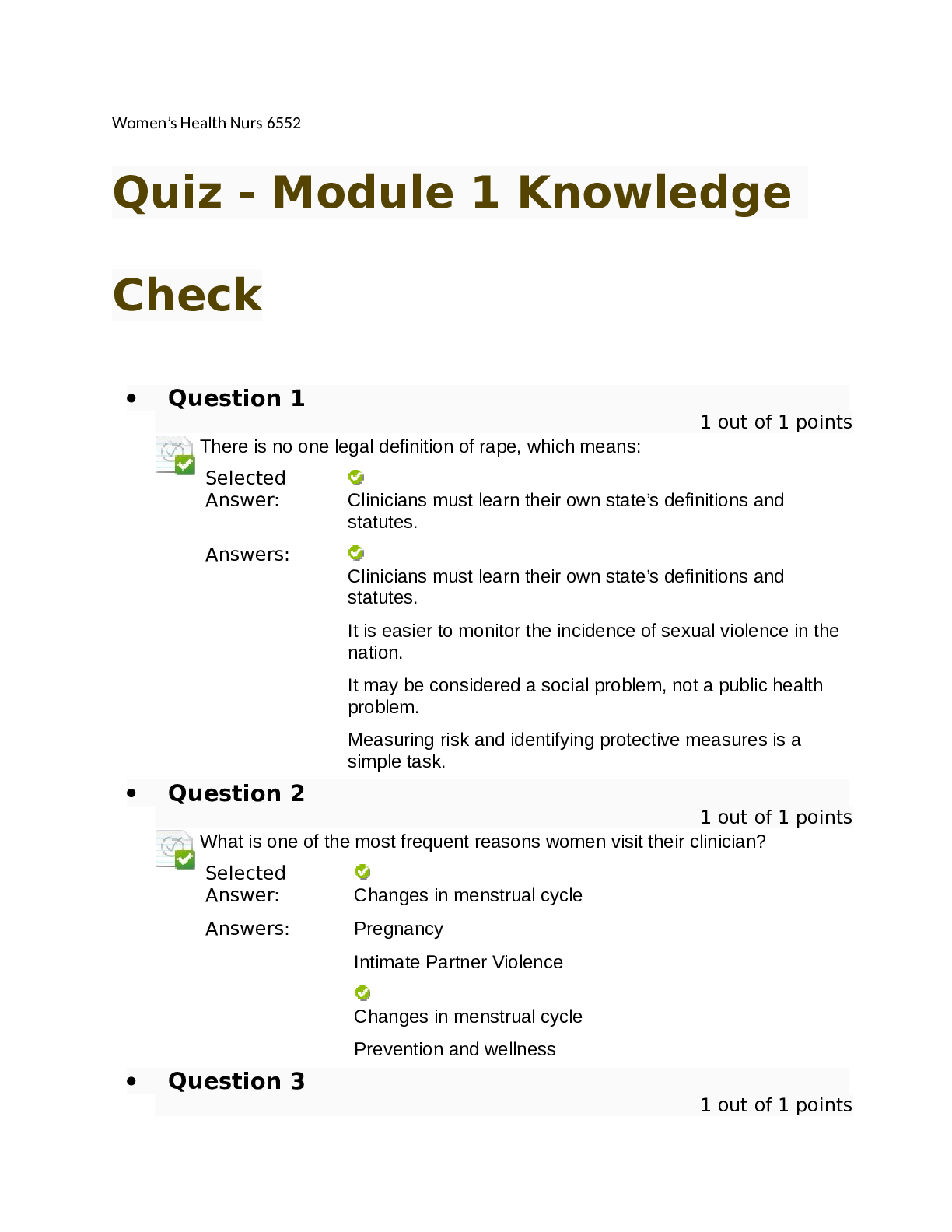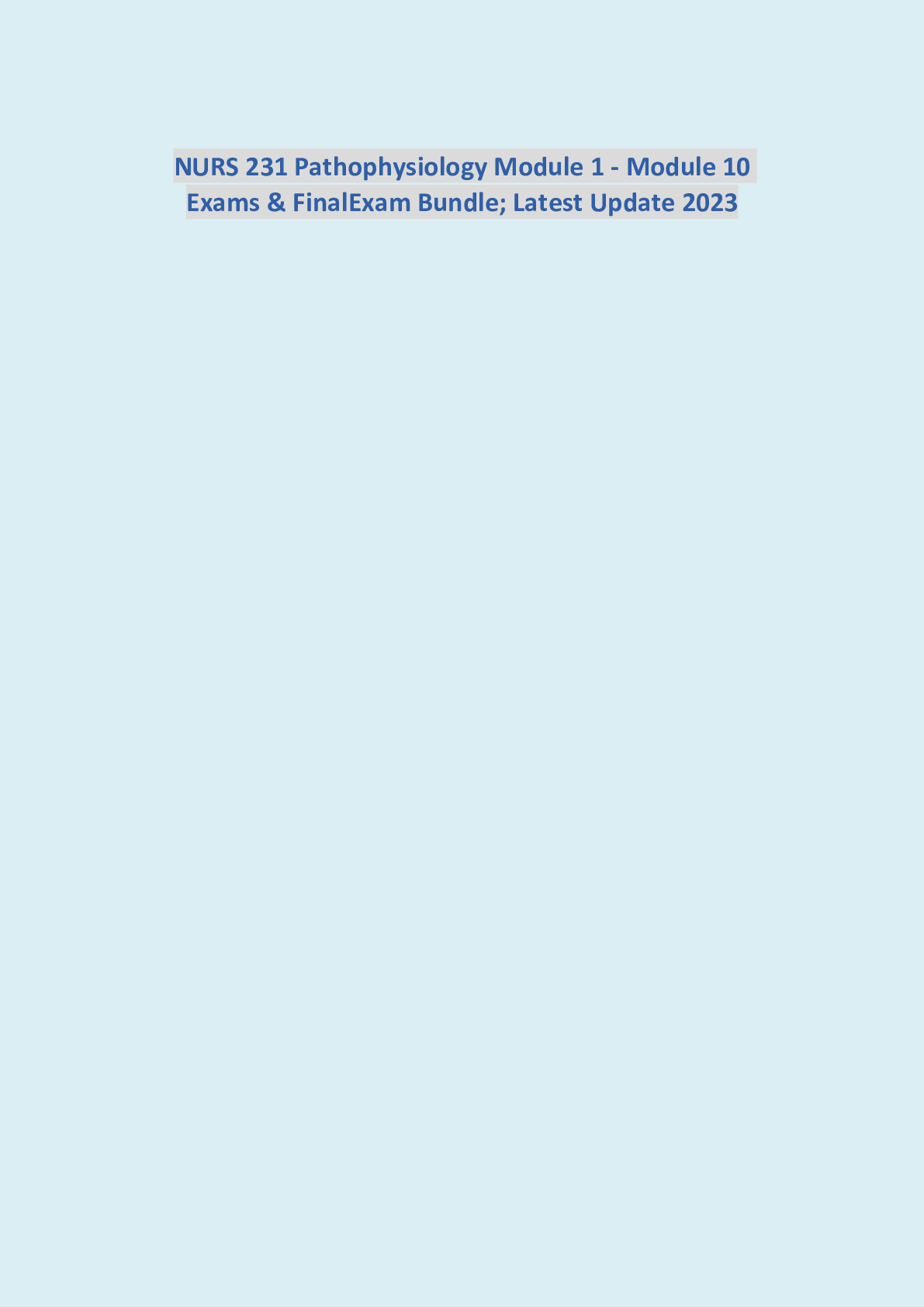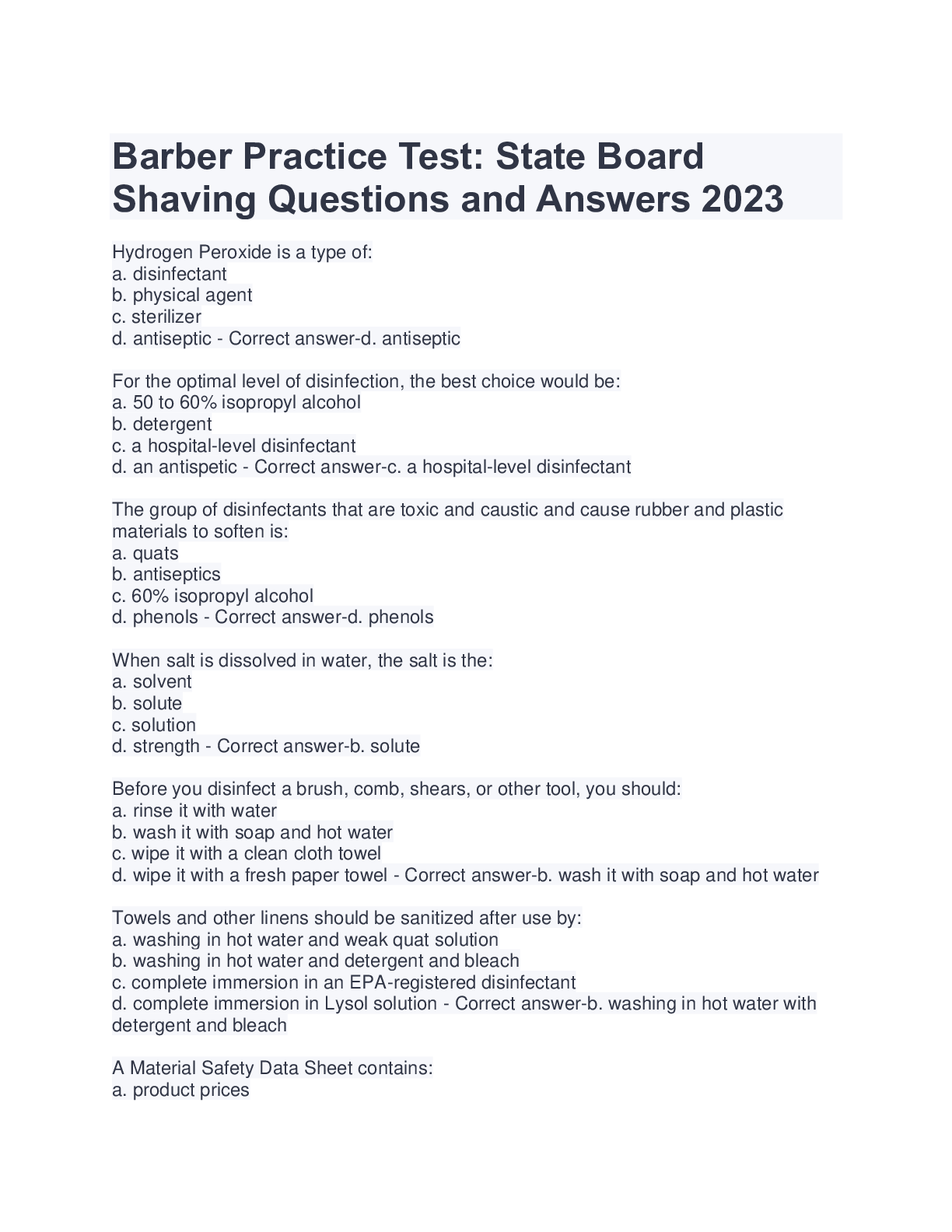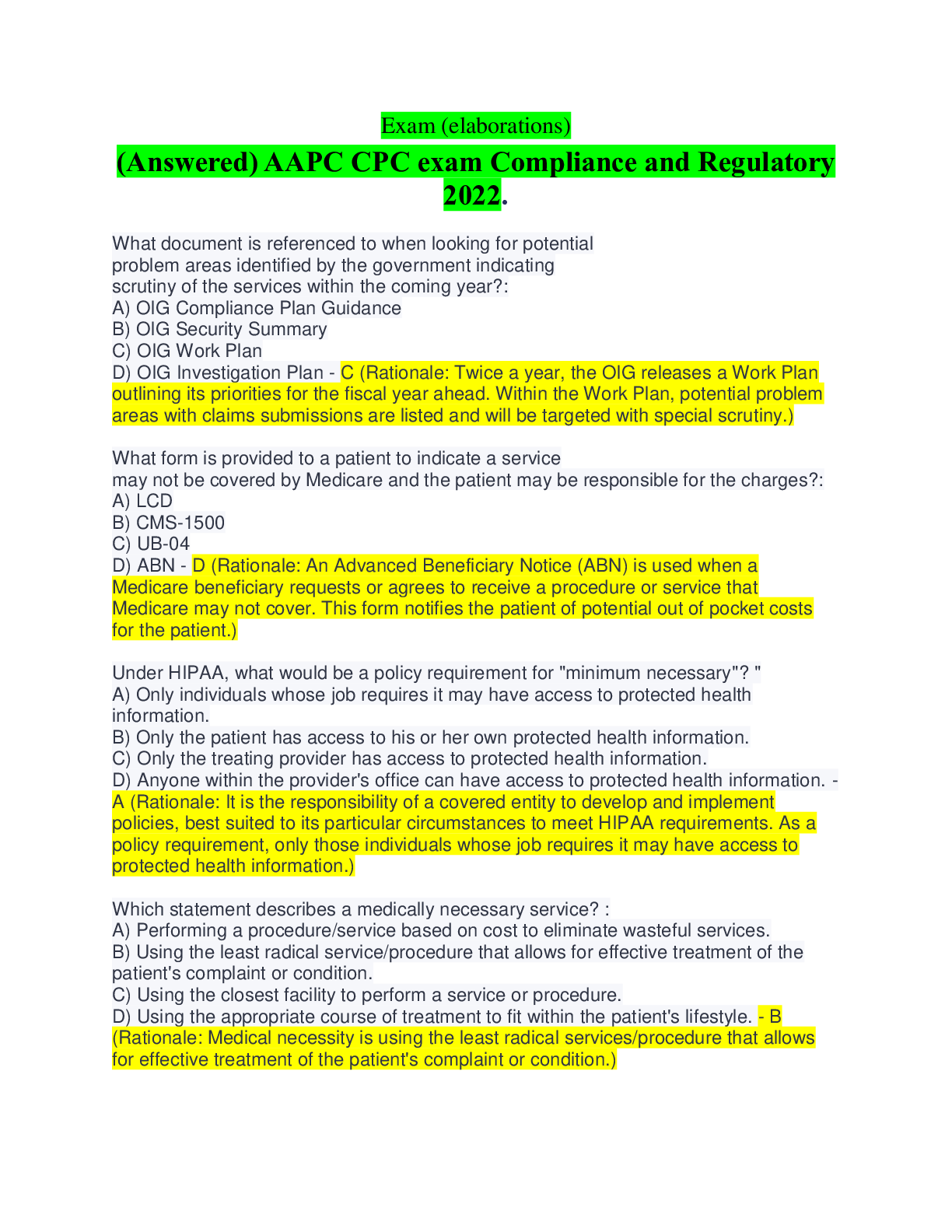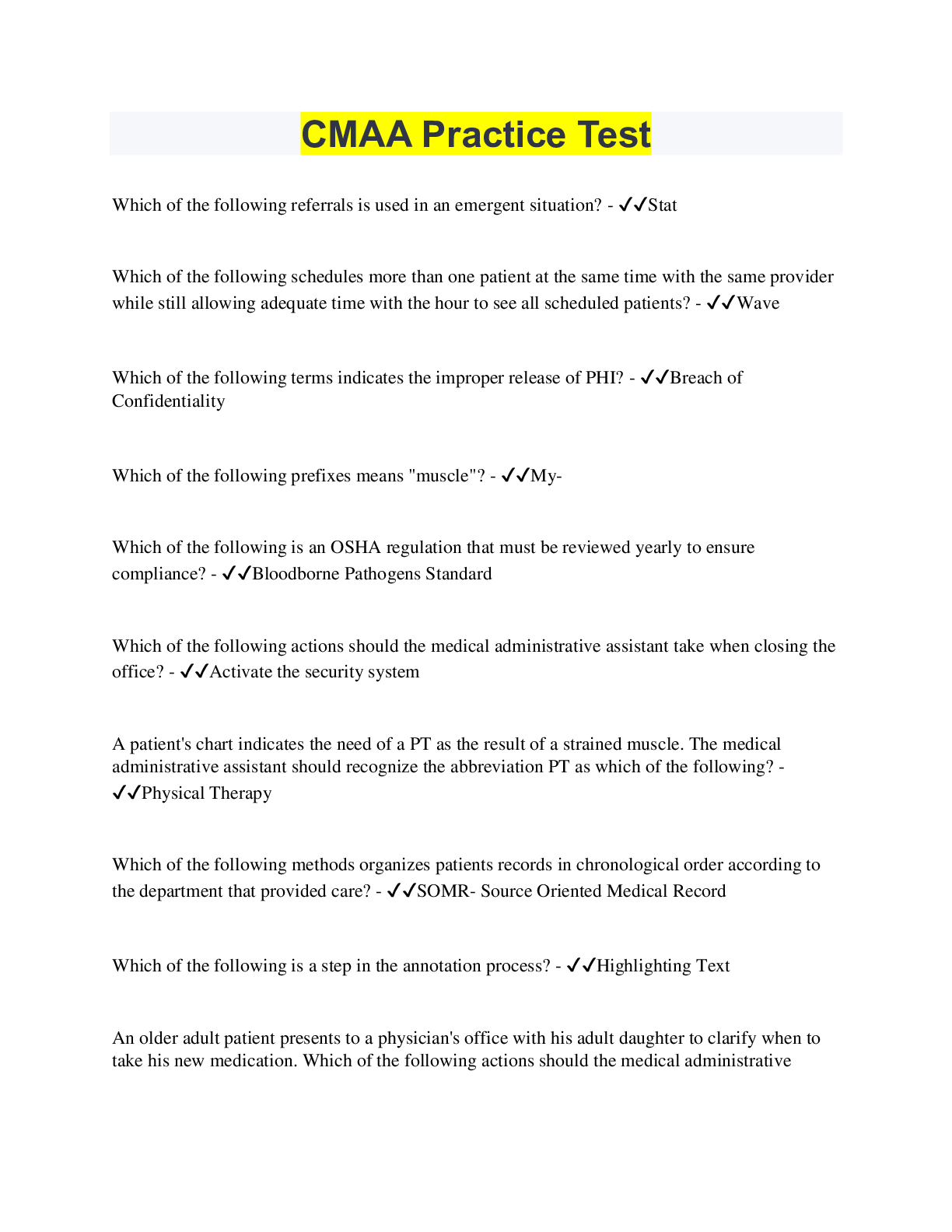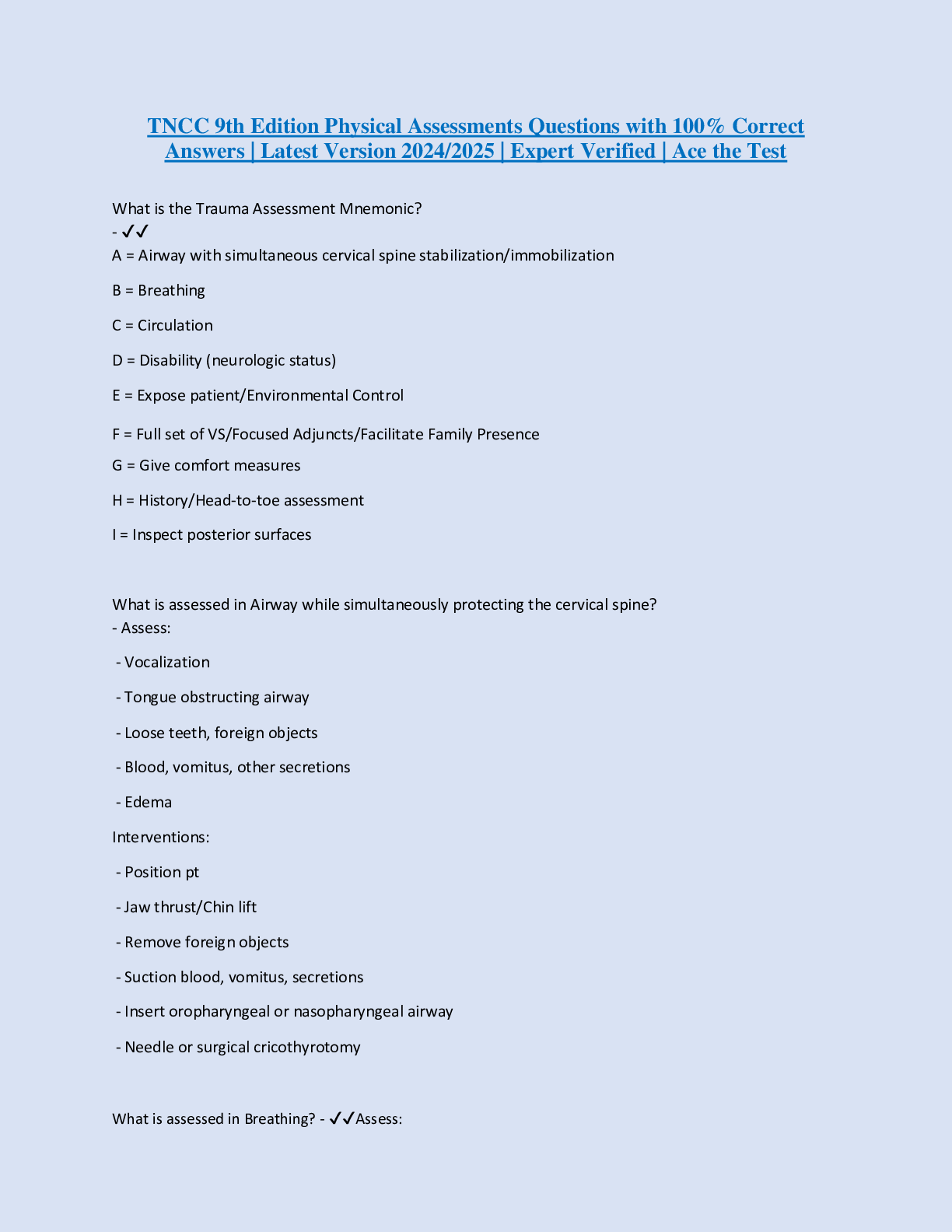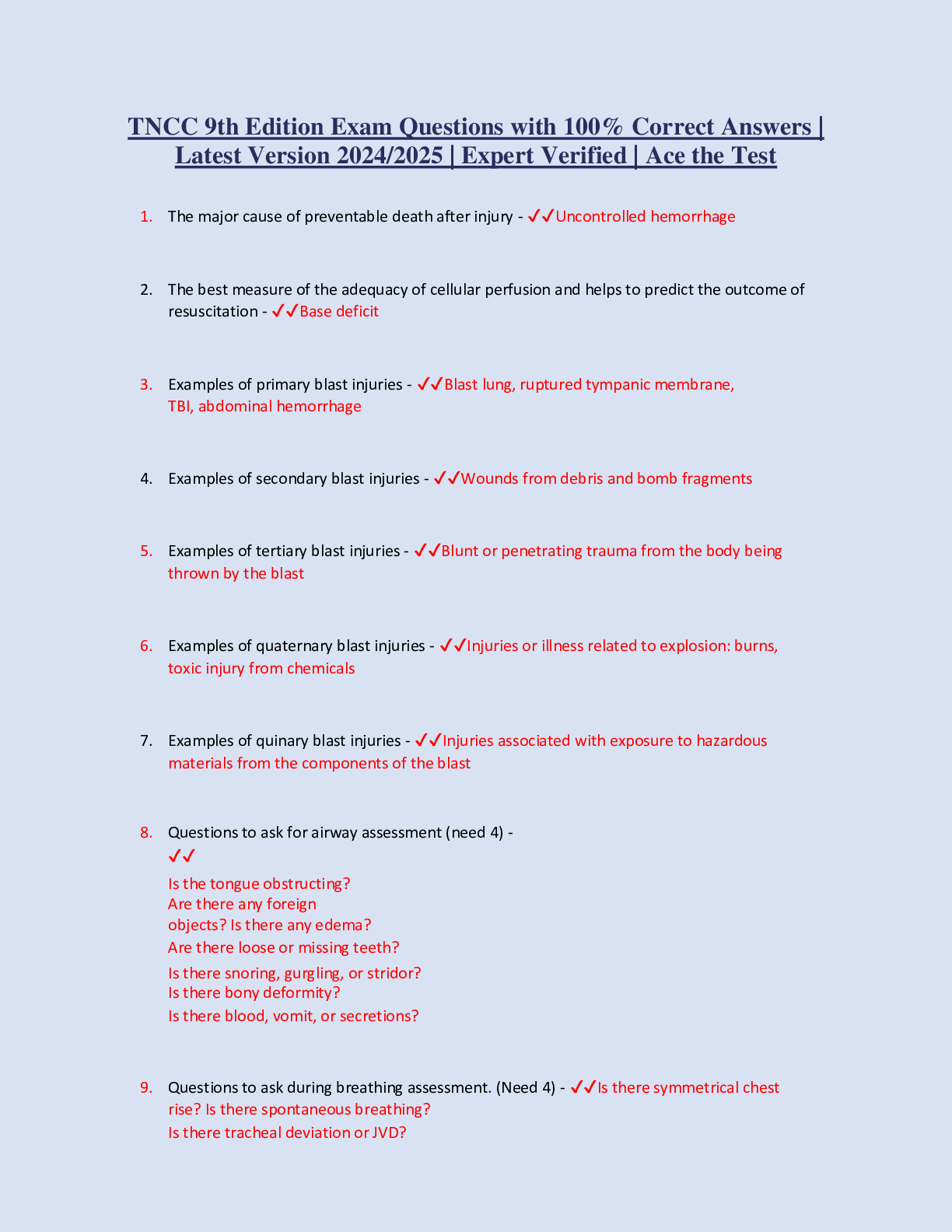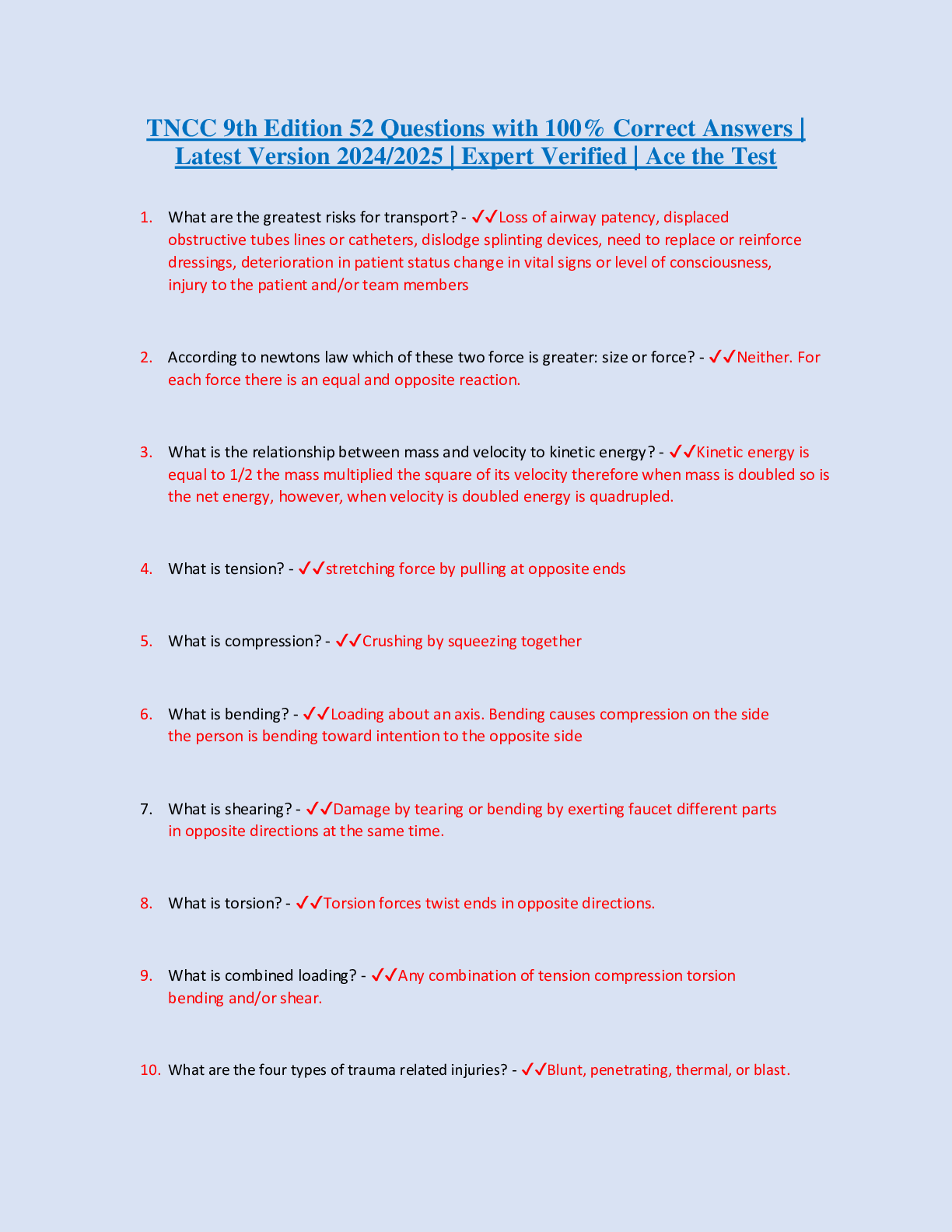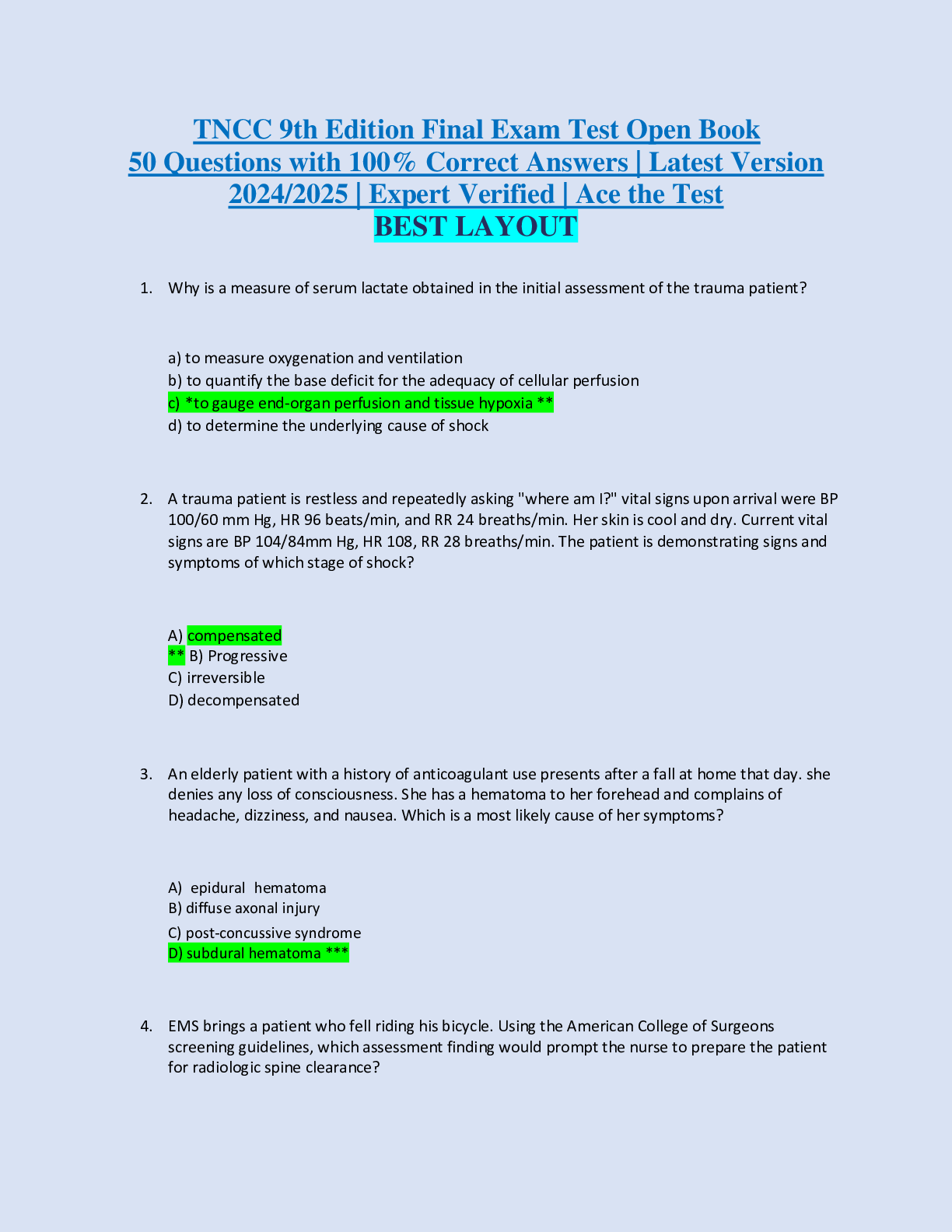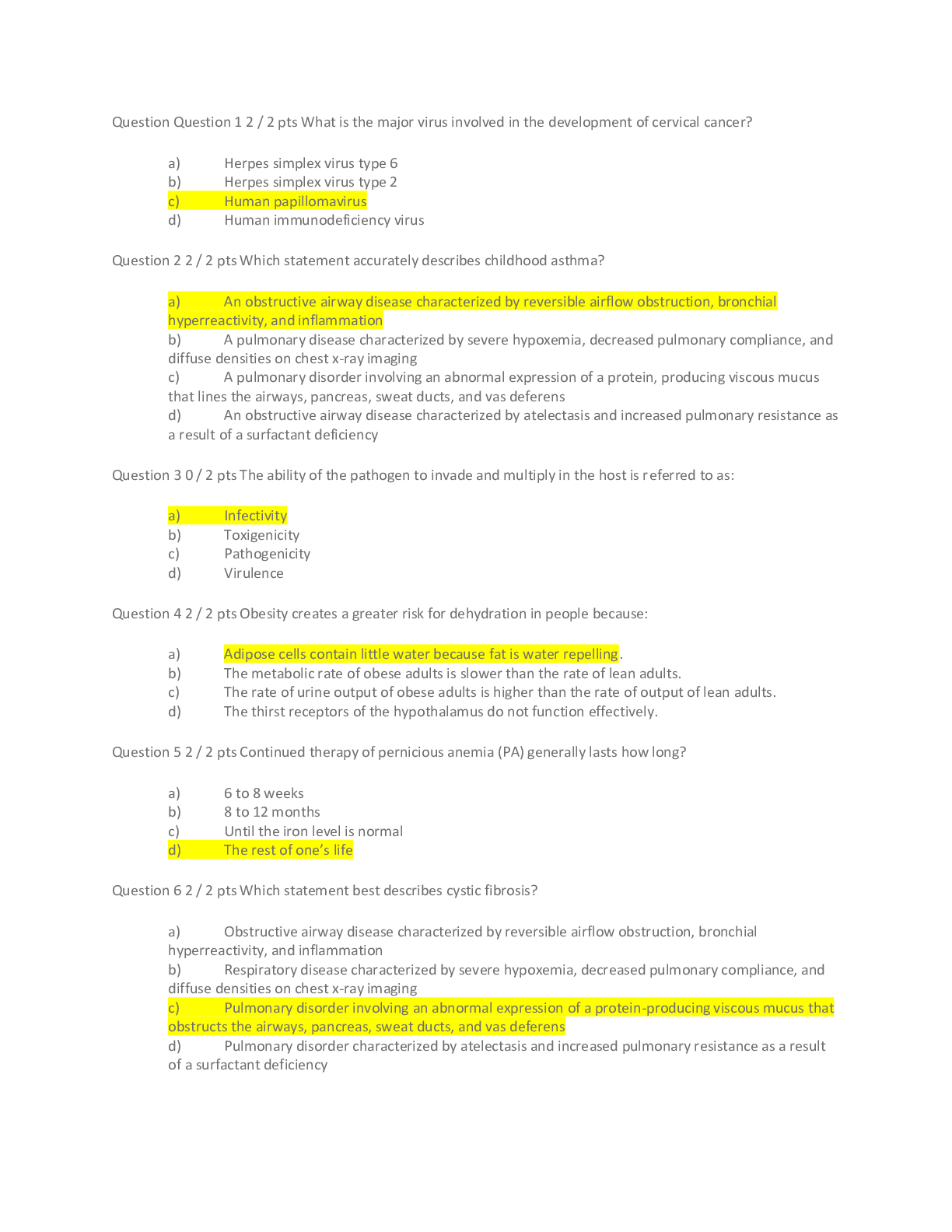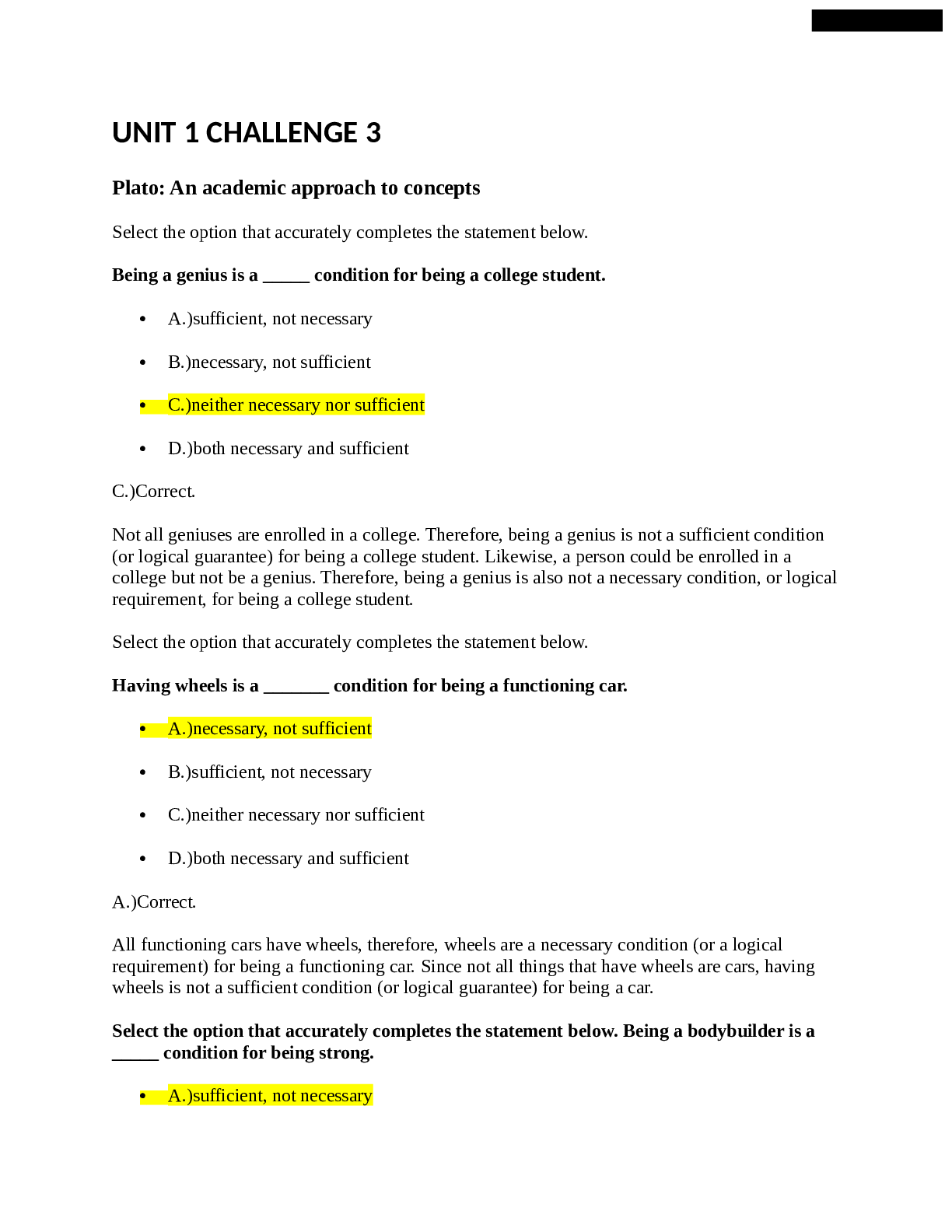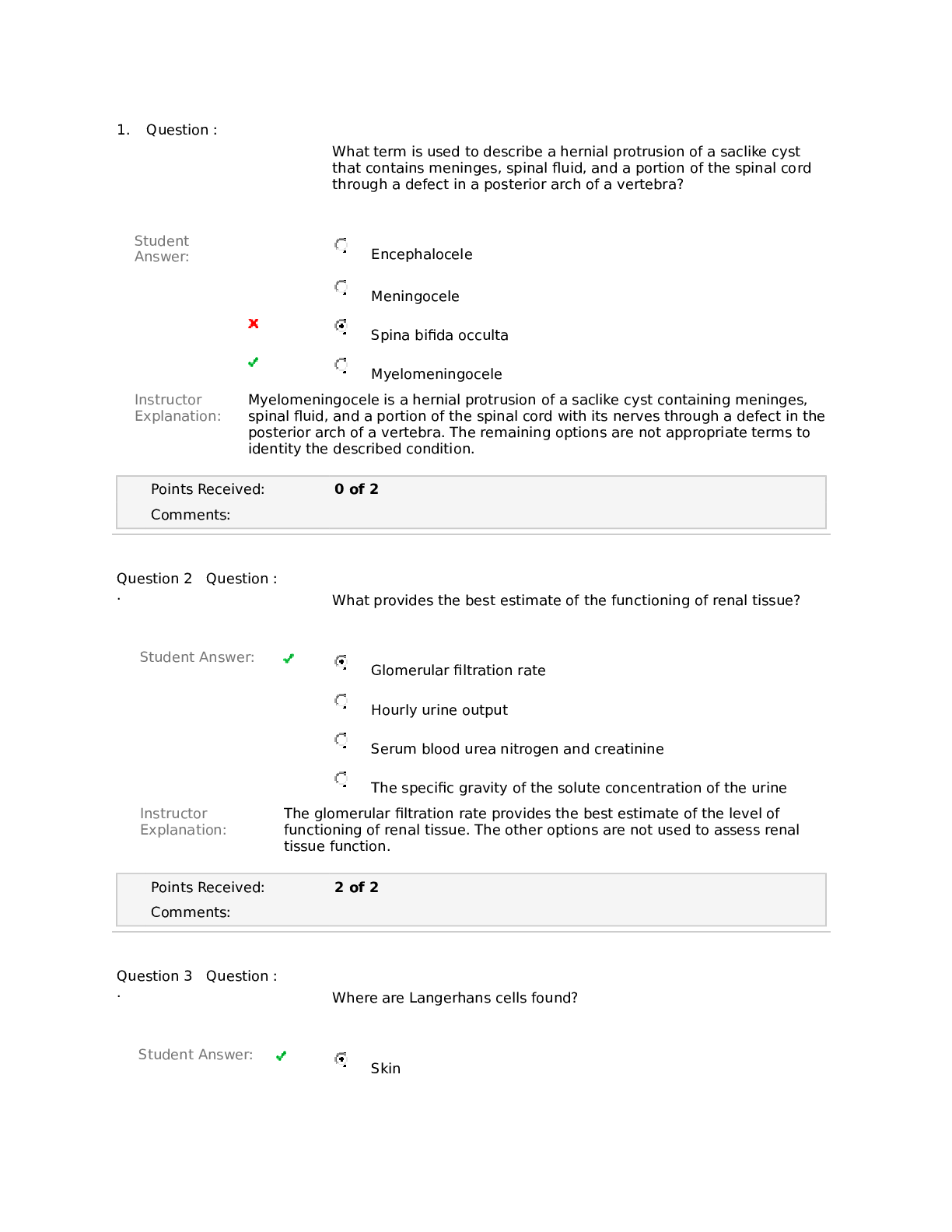NCLEX Kaplan Predictor Test
Document Content and Description Below
The nurse cares for a client with a cuffed tracheostomy tube. Before performing oral care, the nurse notes that the client's tracheostomy cuff is inflated. Which of the following is the MOST appropr... iate action for the nurse to take? 1. Leave the cuff inflated and suction through the tracheostomy. 2. Deflate the cuff and suction through the tracheostomy tube. 3. Inflate the cuff pressure to 40 mm Hg before suctioning. 4. Adjust the wall suction pressure to 160 to 180 mm Hg before suctioning. 1) CORRECT - Implementation: outcome desired; cuff inflation decreases the risk of aspiration; cuff position and pressure should be assessed frequently; swallowing and breathing will cause tracheostomy tube movement 2) Implementation: outcome not desired; accumulated oral secretions above the cuff will drain into the bronchi; increased risk of infection 3) Implementation: outcome not desired; cuff pressure should be less than 20 mm Hg (25 cm H2O); risk of trauma to trachea with higher pressures 4) Implementation: outcome not desired; increases the risk of trauma to lower airways A young adult brings a friend to the emergency department and states that the friend has been using heroin. Which action by the nurse is the MOST appropriate? 1. Assess pupil size and reactivity. 2. Assess oxygen saturation levels. 3. Palpate dorsalis pedis pulses. 4. Ask the client if he knows today's date. 1) Assessment: outcome not priority but may be appropriate; pinpoint pupils are a sign of heroin overdose 2) CORRECT - Assessment: outcome priority; shallow respirations seen; impaired alveolar gas exchange and possible respiratory arrest 3) Assessment: outcome not priority; most important to assess airway and breathing 4) Assessment: outcome not priority but may be appropriate; drowsiness and euphoria may be seen; not priority The client tells the clinic nurse that the client is thinking about using nicotine polacrilex (Nicorette). Which question is MOST important for the nurse to ask? 1. "Have you tried other methods to stop smoking?" 2. "How long have you been smoking?" 3. "Have you ever had chest pain?" 4. "Do you have a partial dental bridge?" 1) Assessment: outcome not priority but may be appropriate; can be asked as part of assessment 2) Assessment: outcome not priority but may be appropriate; should be assessed for further teaching 3) CORRECT - Assessment: outcome priority; action of nicotine is vasoconstriction; increases heart rate and myocardial oxygen consumption; increased risk of angina and myocardial infarction 4) Assessment: outcome may be appropriate but not priority; gum is place between cheek and gums; may stain dental work The nurse cares for the client with a client controlled analgesia (PCA) pump. The nurse determines that the client has pressed the button 11 times and received 6 doses of morphine during the last hour. Which is the MOST appropriate action for the nurse to take? 1. Assess the patency of the PCA IV tubing. 2. Determine the client's understanding of the PCA pump function. 3. Obtain an order to begin a PCA infusion of fentanyl. 4. Ask the client to describe the pain. 1) Assessment: outcome not priority but may be appropriate; if tubing is obstructed, alarm is activated 2) Assessment: outcome may be appropriate but not priority; more important to determine pain level, description of the pain, region and radiation of the pain, and relieving factors 3) Implementation: outcome not desired; more important to assess severity of pain and pain relief first 4) CORRECT - Assessment: outcome priority; must validate that client is in pain before implementation A pregnant woman receives an epidural anesthetic. After administration of the epidural anesthetic, the client's blood pressure changes from 120/84 to 94/50. Which action by the nurse is MOST appropriate? 1. Place the client flat on her back. 2. Elevate the head of the bed 30 degrees. 3. Place the client on her left side with her legs flexed. 4. Place the client supine with the foot of the bed elevated. 1) Implementation: outcome not desired; no increase in venous return 2) Implementation: outcome not desired; will decrease venous return 3) CORRECT - Implementation: outcome desired; will increase venous return and cardiac output; fetal pressure on inferior vena cava reduced 4) Implementation: outcome not desired; elevation of legs will increase venous return, but fetal pressure on vena cava will prevent blood return to heart A nursing order, "Increase fluid intake" is written for a client diagnosed with dehydration. Which finding BEST indicates improving fluid status? 1. Urinary output of 1,500 mL in 24 hours. 2. Serum hematocrit 52%. 3. Oral fluid intake of 900 mL in 24 hours. 4. Blood pressure of 100/82. 1) CORRECT - Assessment: outcome priority; increased amounts of antidiuretic hormone secreted; urine output decreased and concentrated 2) Assessment: outcome not priority; indicates that blood is hemoconcentrated 3) Assessment: outcome not priority; normal intake is 1,500 mL in 24 hours 4) Assessment: outcome not priority; normal BP is 120/80 The nurse prepares to administer the initial dose of oral enalapril (Vasotec) 20 mg in the morning. Which medication should the nurse question giving to the client? 1. 20 mg oral escitalopram (Celexa) in the morning. 2. 40 mg oral furosemide (Lasix) in the morning. 3. 300 mg of oral gabapentin (Neurontin) twice daily. 4. 10 mg zolpidem (Ambien) at bedtime. 1) Implementation: outcome not a problem; no interaction with ACE inhibitors; is an SSRI antidepressant 2) CORRECT - Implementation: outcome potential problem; may promote significant diuresis; first dose of ACE inhibitors increases risk of "first dose" phenomenon due to vasodilation; combination of vasodilation and diuresis increases risk of orthostatic hypotension 3) Implementation: outcome not a problem; no interaction; gabapentin classified as antiseizure medication; off-label use for neuropathic pain 4) Implementation: outcome not a problem; is a hypnotic; no interaction with ACE inhibitors The home care nurse visits a client with a halo fixator traction device. Which client statement MOST concerns the nurse? 1. "My wife looks at the pin sites every day." 2. "I like to bathe in the tub." 3. "I drove to the library yesterday." 4. "I drink with a straw." 1) Assessment: outcome desired; risk of infection at pin sites; client should be taught signs of inflammation and infection 2) Implementation: outcome desired; showers increase risk of infection at pin sites 3) CORRECT - Implementation: outcome not desired and may be a problem; client is not able to turn with halo device; increases the risk of injury to self and others 4) Implementation: outcome desired; difficulty manipulating cup or glass due to immobilized neck The nurse cares for a client diagnosed with depression. Which statement by the client indicates improvement? 1. "I have been sleeping 6 hours at night." 2. "I have lost 2 lbs in the past week." 3. "Lately, I have trouble watching television." 4. "I have much less muscle tension now." 1) CORRECT - Assessment: outcome desired; clients with depression may have increased or decreased sleep time 2) Assessment: outcome not desired; lack of appetite is a frequent sign of depression 3) Assessment: outcome not desired; lack of concentration is sign of depression 4) Assessment: outcome not desired; is a sign of anxiety The nurse on the maternity unit must accept a transfer client from a medical/surgical unit. The nurse considers which transfer client appropriate? 1. A 38-year-old client with a diagnosis of systemic lupus erythematosus. 2. A 45-year-old client receiving daily external radiation therapy treatments for breast cancer. 3. A 58-year-old client receiving antibiotic treatment for cellulitis of the left leg. 4. A 74-year-old client who has received intravenous antibiotics for 7 days. 1) CORRECT - Implementation: outcome desired; autoimmune disease; not infectious 2) Implementation: outcome not desired; possible skin damage and suppression of bone marrow with decreased white-blood-cell levels; increased risk for infection 3) Implementation: outcome not desired; generalized skin infection of deeper connective tissue; usually caused by Streptococcus or Staphylococcus; increased risk for infection 4) Implementation: outcome not desired; elderly clients receiving long-term antibiotic therapy are at risk for Clostridium difficile infection; highly contagious; increased risk for infection The nurse in the outclient surgery unit prepares a 4-year-old child for surgery. It is MOST important for the nurse to make which of these statements? 1. "Your parents are going to leave a half hour before the surgery." 2. "You're going to talk with some other children who had this surgery." 3. "If you have this surgery, your parents will buy you a new toy." 4. "Take this doll and show me where the operation will be done." [Show More]
Last updated: 1 year ago
Preview 1 out of 63 pages
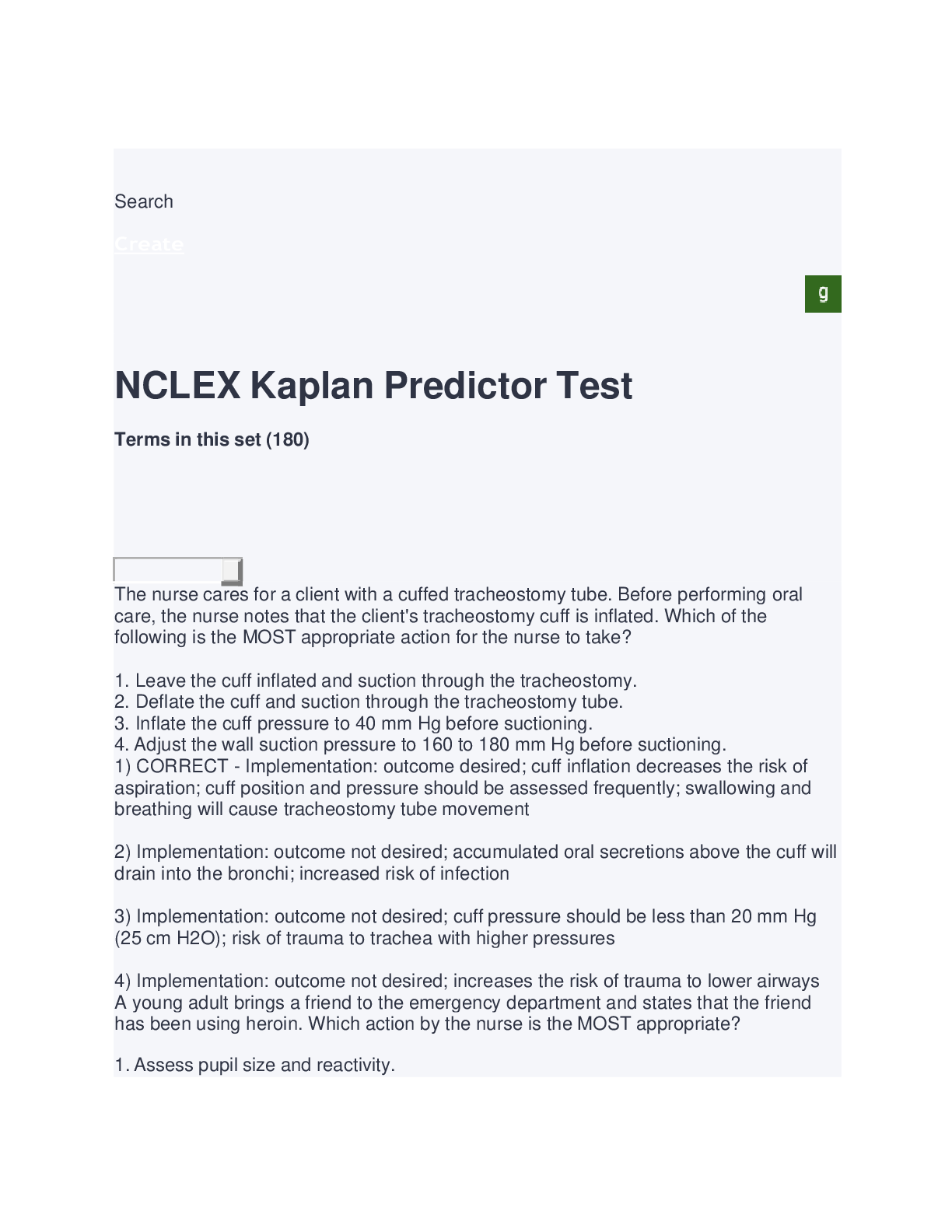
Also available in bundle (3)

NCLEX EXAM QUESTIONS AND ANSWERS 2023/2024
NCLEX EXAM QUESTIONS AND ANSWERS 2023/2024
By Tutor Charles 8 months ago
$150.5
24

NCLEX EXAM QUESTIONS AND ANSWERS 2023/2024
NCLEX EXAM QUESTIONS AND ANSWERS 2023/2024
By Tutor Charles 8 months ago
$150.5
27

Kaplan Predictor Test NCLEX
NCLEX Kaplan Predictor Test
By Tutor Charles 1 year ago
$36.5
3
Reviews( 0 )
Document information
Connected school, study & course
About the document
Uploaded On
Jan 20, 2023
Number of pages
63
Written in
Additional information
This document has been written for:
Uploaded
Jan 20, 2023
Downloads
0
Views
62

